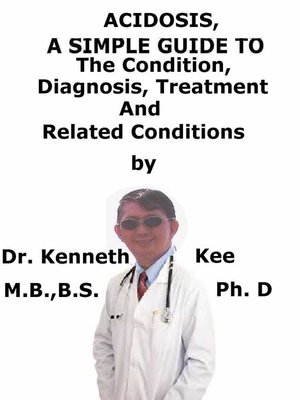Acidosis, a Simple Guide to the Condition, Diagnosis, Treatments and Related Conditions
ebook
By Kenneth Kee

Sign up to save your library
With an OverDrive account, you can save your favorite libraries for at-a-glance information about availability. Find out more about OverDrive accounts.
Find this title in Libby, the library reading app by OverDrive.



Search for a digital library with this title
Title found at these libraries:
| Library Name | Distance |
|---|---|
| Loading... |
Acidosis is a medical disorder in which there is too much acid in the body fluids.It is just the opposite of alkalosis (too much base inside the body fluids).When the body fluids have too much acid, this is termed acidosis.Acidosis happens when the kidneys and lungs can not keep the body's pH in balance.Many of the body's actions produce acid.The lungs and kidneys can normally compensate for slight pH imbalances but disorders with these organs can result in excess acid in the body.The acidity of the blood is assessed by determining its pH.Acidosis is characterized by a pH of 7.35 or less.Acidosis happens when acid accumulates or when a base (bicarbonate) is eliminated.Acidosis can result in numerous health problems, and it can even be life-threateningAcidosis is classified as either respiratory or metabolic acidosis.Metabolic Acidosis:1. Diabetic acidosis happens in people with diabetes that is poorly regulated2. Hyperchloremic acidosis occurs from a loss of sodium bicarbonate3. Lactic acidosis happens when there is too much lactic acid in the bodySymptoms of respiratory acidosis are:1. Fatigue or drowsiness2. Confusion3. Shortness of breath4. HeadacheSymptoms of metabolic acidosis are:1. Rapid and shallow breathing2. Confusion3. Fatigue4. Headache5. Breath that smells fruityAn arterial blood gas looks at the levels of oxygen and carbon dioxide in the blood.It also shows the blood pHThe first diagnosis of an acidosis problem may be presence of low serum bicarbonate on testing.Treatment is aimed at the underlying condition.Doctors normally require knowing what is causing the acidosis to determine how to treat it.However, some treatments can be used for any type of acidosis.The doctor may give the patient sodium bicarbonate (baking soda) to raise the pH of the blood.This can be done either orally or through an intravenous (IV) drip.The patient might also be given oxygen.Respiratory AcidosisTreatments for this condition are normally designed to help the lungs.The patient may be given drugs to dilate the airway.The patient might also be given oxygen or a continuous positive airway pressure (CPAP) device.The CPAP device can help the patient breathe if the patient has an obstructed airway or muscle weakness.Metabolic AcidosisThe specific forms of metabolic acidosis have their individual treatments.People with hyper-chloremic acidosis may be administered oral sodium bicarbonate.Acidosis as a result from kidney failure may be treated with sodium citrate.Diabetics with ketoacidosis receive intravenous fluids and insulin to correct their pH.Lactic acidosis treatment is:1. Bicarbonate supplements,2. IV fluids,3. Oxygen,4. Antibiotics, depending on the cause.In some patients, sodium bicarbonate (the chemical in baking soda) may be given to reduce the acidity of the blood.Patients with metabolic acidosis are often very ill and prone to rapid deterioration.Acidosis can be dangerous if untreated.Many patients respond well to treatment.TABLE OF CONTENTIntroductionChapter 1 AcidosisChapter 2 CausesChapter 3 SymptomsChapter 4 DiagnosisChapter 5 TreatmentChapter 6 PrognosisChapter 7 HeatstrokeChapter 8 DehydrationEpilogue







